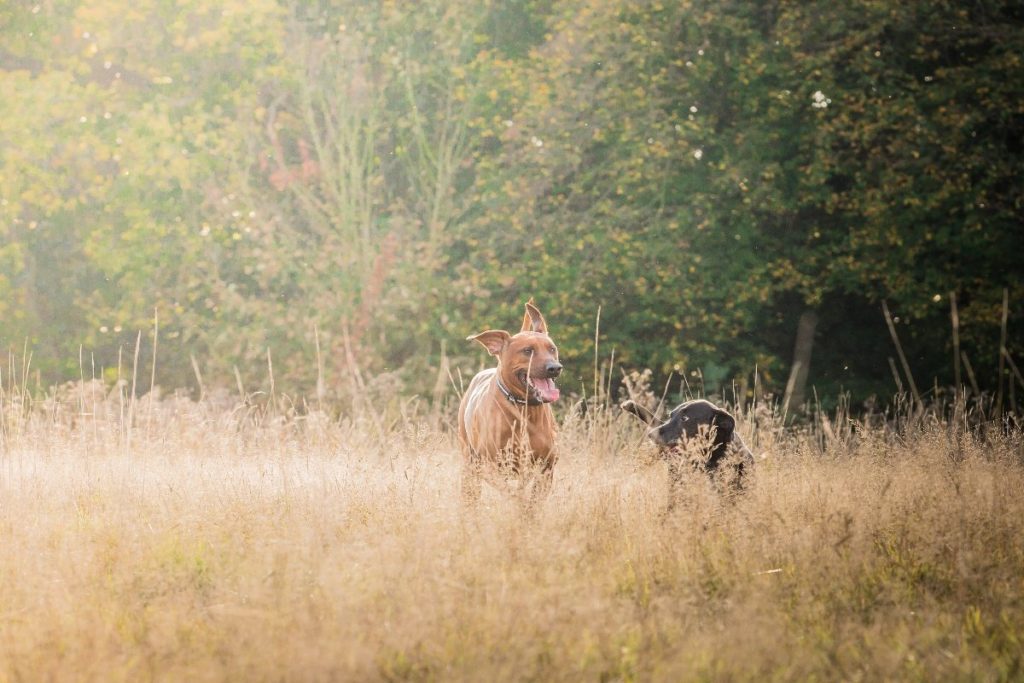As many pet owners will know, we are now entrenched in tick season. These pesky parasites are at their most active in the warmer weather from March to October, so now is the time to be extra vigilant and check your pet for ticks regularly. But what exactly are ticks, what should you look for and what do you do if you find one? Our resident vet nurse Sophie explains all…
Ticks are small, spider-like creatures that we tend to find in long grassy areas. The ticks sit at the top of grass stalks and attach themselves onto a passing meal as the ‘host’ (your dog…or you!) brushes past.
Ticks can’t fly or jump but hold their front pair of legs stretched out to latch onto your dog by sensing body odours, heat and breathing as the mammal brushes past. Once attached the tick will then feed on blood before dropping off when full and perhaps tripling in size! As ticks thrive in grassy, woodland and damp marshy habitats, most ticks are picked up by dogs when out on walks.
Where on my dog might I find a tick?
Common areas to find ticks on a dog’s body are ears, around the eyes, groin, armpits, abdomen, between the toes and under the tail. Generally, ticks will attach to any area of exposed skin and less hair where there are rich blood vessels close to the surface. These areas are therefore best checked first after a dog walk. Ticks have the most success on short haired breeds where it is easier for them to reach the skin.
Some areas of the dog’s body can be mistaken for ticks – nipples that aren’t evenly spaced or skin ‘tags’ often seen on the skin of older dogs that can also look like little warts. If you are not sure, pop your dog to the vets where a nurse will be able to check for you so you are not trying to remove a part of the dog’s anatomy! If you simply can’t bear the thought of having to try and remove a tick they can remove it for you.
What’s the best way to remove a tick myself?
When removing a tick, try to do it as soon as you notice it. This will minimise the time it has to transfer any microorganisms it might be carrying to your dog. It is important to do it gently, ensuring you remove the mouthparts. All dog owners should invest in a tick twister/ hook. The duo packs are the best as they contain two different sizes of hook. One for small ticks and one for bigger ticks. By using this tool you can ensure the mouth parts are not left behind by hooking around the tick against the dog’s skin and gently turning anti-clockwise. NEVER hook and pull.
It is not recommended to remove a tick with tweezers. If you grasp the tick by its body it will inject toxins into the dog’s blood. Smothering a tick in Vaseline or applying alcohol to its body will also cause it stress which will in turn risk it regurgitating its meal back into the dog’s bloodstream, increasing the risk of infection.
Why are ticks so dangerous?
The well-known disease in humans – Lymes disease – is caused by bacteria in tick saliva. Lymes disease causes lethargy, muscle and joint pain, headaches and can cause a rash in the form of a bullseye where the tick was attached. Sometimes however the rash isn’t present.
In dogs, they can pick up a bacterial infection of white blood cells (Ehrlichia). The disease is more common in dogs that have picked up a tick bite abroad.
Another blood disease is Babesia infecting the red blood cells. Again this is seen more commonly in dogs that have travelled but has been seen in dogs that have not left the UK.
Tick Prevention
Products on the market to kill ticks range from spot-ons, tablets and collars. These products diffuse antiparasitic treatment into the fatty layers of the dog’s skin, causing the tick to detach itself. However, the tick has to bite for this to be effective with all but the collar.
The Seresto collar repels ticks and fleas for 8 months releasing low concentrations of an anti-parasitic through the skin and coat so the parasites are killed through contact with the active ingredient rather than having to bite.
Keeping up to date with tick treatment is essential if you travel abroad with your dog. If you live and walk in areas that are favourable for tick habitat or your dog comes into contact with areas of wildlife that act as tick hosts like deer, fox, hedgehogs and pheasants it is best to do regular tick checks.




